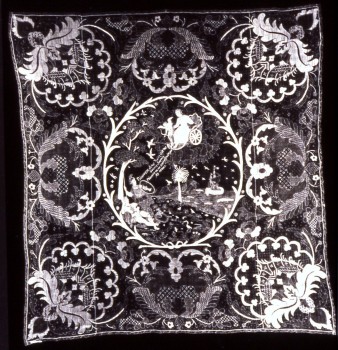
curtain of Dinant, Belgium, 18th
century, Inv.Nr. TM 21397
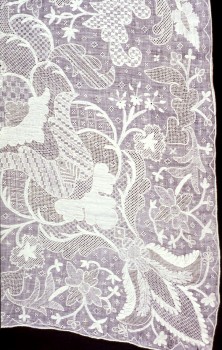
Detail of Dinant embroidery
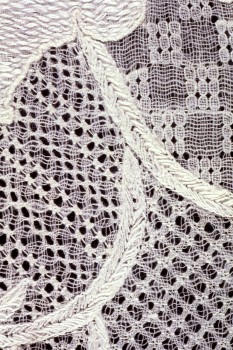
Detail of Dinant embroidery
Annatextiles VOCABULAR - Embroideries |
| Index---alphabetical order---Embroideries |
Weissstickerei |
Whitework Embroidery |
Broderie blanche |
Ricamo bianco |
| Whitework Embroideries parts of a paper, given at the CIETA meeting of 1989 in Chicago USA, by Anne Wanner-JeanRichard Introduction: In the 18th and 19th century there were several centres which produced whitework embroideries. The textile collection of St. Gallen has some pieces of these centres. Few of them are dated. The earliest embroidery on cotton is an english apron with the date of 1711. As for the technique we find satin stitch, chainstitch, and drawn work. Probably also from the first half of the 18th century is the cover or curtain of Dinant. I have not been able to find literature or documents of this region in Belgium. Again there is satinstitch, buttonholestitch and fine drawn work. From Saxony I show an example with the date of 1763, which is the date of the peace of Hubertusburg. Drawn work is a speciality of Saxony. In the 19th century whitework was done in Ayr, Scottland. In St.Gallen there is a collection of baby dresses. The example is not dated, but M. Swain gives some dates in her book: Mrs Jamieson of Ayr, Scottland, established a considerable business from 1814 to 1830. She is said to habe controlled a thousand outworkers. The finest pieces were done in the 1830s and they were voted equal to french work. The end of the Scottish embroidery came in 1857 because of a financial crisis in Glasgow and concurrence of machine embroidery. In Bohemia Miroslava Ludvicova describes three waves of development. Specially the second, from 1830 to 1860 brought many fine works. From 1850 to the end of the century there is a tendency to work quickly. Still in 19th century special caps were embroidered in "bourbonnaises", France. There is almost no literature on them, but there is an extremely high number of examples in the collection of St. Gallen. The lace stitch is very similar to the lace stitch used in Switzerland. On the reverse side we note the difference to swiss works. In France there is quite often chainstitch which gives the effect of small dots on the frontside. |
In the 19th c. whitework embroideries were made in Denmark (Hedebo), in Norway (Hardanger), in Ireland (Mountmellik) as well. Also of 19th century are the fine whitework embroideries with rich drawn work of Manila. Sandra Castro of Manila is writing a thesis of this kind of works: Several local fabrics made of vegetable fiber are usually identified as "grasscloth". New research work shows that 2 qualities can be distinguished: Pina means the cloth made from leaves of the pineapple plant. Nippis were exported specially to Spain. Primary sources say that this is a fine grade of cloth manufactured from plantain. With these fabrics it is possibel to make the finest drawnworks. In the last years of 19th century, swiss machine embroiderers imitated Manila work and other types of white works with the embroidery machines. Literatur: - Anne Wanner, Kopf und Kragen, Begleitheft zur Ausstellung vom 7. Mai 1992 bis Frühling 1993 - Margaret Swain, Ayrshire and other Whitework, London 1982 - Sheila Paine, Chikan Embroidery, The Floral Whitework of India, Great Britain 1989 - Andree Piboule, 750 Coiffes Bourbonnaises, Marsat, 1985 - Miroslava Ludvikova, Maehrische Volksstickerei, in: Moravska lidova vysivka, Brno 1986 - Sandra Caastro, Nipis, in: Ausstellungskatalog, Intramuros Manila 1990 - Gisela Graf-Hoefgen, Schlesische Spitzen, München 1974 |
| Die
nachfolgenden Beispiele stammen aus der Sammlung des Textilmuseums St.Gallen (Schweiz) Details von Weissstickereien in Baumwolle und Leinen |
The following
examples belong to the collection of the Textilmuseum St.Gallen (Switzerland) Details of whitework embroideries with embroidery in cotton and linen threads. |
|
|
|
|
|
|
|
|
|
|
|
|
|
|
|
|
|
|
|
|
|
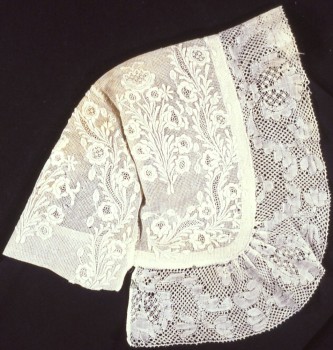 Cap, Bohemia around 1800, Inv.Nr. TM 22759 |
|
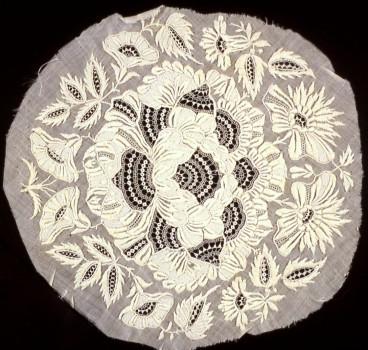 back of a woman's cap, France 19th century |
|
|
Chikan embroidery: |
|
|
|
|
|
|
|
|
|
|
|
Photonachweis: |
| embroideries names index |
Last revised August, 2016 | For further information contact Anne Wanner wanner@datacomm.ch |